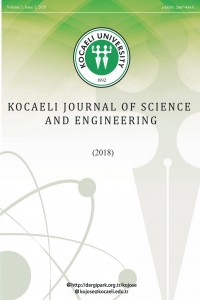Abstract
References
- [1] Bormann P., Wendt S., DiGiacomo D., 2013. Seismic Sources and Source Parameters. In: Bormann P. (Ed.), New Manual of Seismological Observatory Practice 2 (NMSOP2), Potsdam, Germany. https://doi.org/10.2312/GFZ.NMSOP-2_ch3.
- [2] Bormann P., 2011. Earthquakes, Intensity in Encyclopedia of Solid Earth Geophysics, Springer, Dordrecht, The Netherlands.
- [3] Musson R. M., Cecić I., 2012. New Manual of Seismological Observatory Practice 2 (NMSOP-2). doi.org/10.2312/GFZ.NMSOP-2_ch12.
- [4] Wald D. J., Quitoriano V., Heaton T. H., Kanamori H., 1999. Relationships Between Peak Ground Acceleration, Peak Ground Velocity, and Modified Mercalli Intensity in California. Earthquake Spectra, 15(3), pp.557-564.
- [5] Grünthal G., 2011. Earthquakes, Intensity in Encyclopedia of Solid Earth Geophysics, Springer, Dordrecht, The Netherlands.
- [6] 24 Ocak 2020 Elazığ Sivrice Depremi Basın Bülteni, http://www.koeri.boun.edu.tr/sismo/2/wp-content/ uploads/2020/01/24_Ocak_2020_Sivrice_Elazig_Depremi_V13.pdf. (Access Date: 23.10.2020).
- [7] Richter C. F., 1935. An Instrumental Earthquake Magnitude Scale. Bulletin of the Seismological Society of America, 25(1), pp.1-32.
- [8] Kanamori H., 1977. The Energy Release in Great Earthquakes. Journal of Geophysical Research, 82(20), pp.2981-2987.
- [9] Kanamori H., Brodsky E. E., 2004. The Physics of Earthquakes. Reports on Progress in Physics, 67(8), pp.1429
- [10] Earthquake Glossary Seismic moment, https://earthquake.usgs.gov/learn/glossary/?term= seismic%20moment (Access Date: 24.10.2020).
- [11] Campbell K.W., 1985. Strong Motion Attenuation Relations: a Ten-Year Perspective. Earthquake Spectra, 1(4), pp.759-804.
- [12] Kanamori H., 1983. Magnitude Scale and Quantification of Earthquakes. Tectonophysics, 93(3-4), pp.185-199.
- [13] Bormann P., 2002. Magnitude of Seismic Events. IASPEI New Manual of Seismological Observatory Practice, 1, pp.16-50.
Abstract
Earthquake size is one of most fundamental source parameter to be used in seismic catalogs. A reliable measure of the “size” of an earthquake is essential for seismological, geological, engineering, seismic risk analysis and scientific researh. The size of a seismic source is measured using two parameters; damage caused (intensity) and energy released (magnitude). Intensity describes the strenght of a seismic event in terms of human recognition, affected region, damage on structures. Intensity depends on local geological conditions, distance from the source that make the objective estimates difficult. Intensity scales are valuable not only for pre-instrumental period for historical earthquakes but also for seismic risk analysis. Intensity scale is classified by macroseismic scales. The advent of seismic recording systems made it possible to determine strength of a seismic event from instrumental data. The concept of magnitude was introduced by Richter to provide objective measure of earthquake size. Magnitude of an earthquake provide quick information on the strength of a seismic event for public and are essential for cataloging. Changes in instrumentation and magnitude formulation resulted calculation of different magnitude scales. In order to obtain a non-saturating uniform magnitude scale, seismic moment magnitude (Mw) is developed based on source parameters.
References
- [1] Bormann P., Wendt S., DiGiacomo D., 2013. Seismic Sources and Source Parameters. In: Bormann P. (Ed.), New Manual of Seismological Observatory Practice 2 (NMSOP2), Potsdam, Germany. https://doi.org/10.2312/GFZ.NMSOP-2_ch3.
- [2] Bormann P., 2011. Earthquakes, Intensity in Encyclopedia of Solid Earth Geophysics, Springer, Dordrecht, The Netherlands.
- [3] Musson R. M., Cecić I., 2012. New Manual of Seismological Observatory Practice 2 (NMSOP-2). doi.org/10.2312/GFZ.NMSOP-2_ch12.
- [4] Wald D. J., Quitoriano V., Heaton T. H., Kanamori H., 1999. Relationships Between Peak Ground Acceleration, Peak Ground Velocity, and Modified Mercalli Intensity in California. Earthquake Spectra, 15(3), pp.557-564.
- [5] Grünthal G., 2011. Earthquakes, Intensity in Encyclopedia of Solid Earth Geophysics, Springer, Dordrecht, The Netherlands.
- [6] 24 Ocak 2020 Elazığ Sivrice Depremi Basın Bülteni, http://www.koeri.boun.edu.tr/sismo/2/wp-content/ uploads/2020/01/24_Ocak_2020_Sivrice_Elazig_Depremi_V13.pdf. (Access Date: 23.10.2020).
- [7] Richter C. F., 1935. An Instrumental Earthquake Magnitude Scale. Bulletin of the Seismological Society of America, 25(1), pp.1-32.
- [8] Kanamori H., 1977. The Energy Release in Great Earthquakes. Journal of Geophysical Research, 82(20), pp.2981-2987.
- [9] Kanamori H., Brodsky E. E., 2004. The Physics of Earthquakes. Reports on Progress in Physics, 67(8), pp.1429
- [10] Earthquake Glossary Seismic moment, https://earthquake.usgs.gov/learn/glossary/?term= seismic%20moment (Access Date: 24.10.2020).
- [11] Campbell K.W., 1985. Strong Motion Attenuation Relations: a Ten-Year Perspective. Earthquake Spectra, 1(4), pp.759-804.
- [12] Kanamori H., 1983. Magnitude Scale and Quantification of Earthquakes. Tectonophysics, 93(3-4), pp.185-199.
- [13] Bormann P., 2002. Magnitude of Seismic Events. IASPEI New Manual of Seismological Observatory Practice, 1, pp.16-50.
Details
| Primary Language | English |
|---|---|
| Subjects | Engineering, Geology (Other) |
| Journal Section | Review |
| Authors | |
| Publication Date | November 30, 2020 |
| Acceptance Date | October 25, 2020 |
| Published in Issue | Year 2020 Volume: 3 Issue: 2 |

